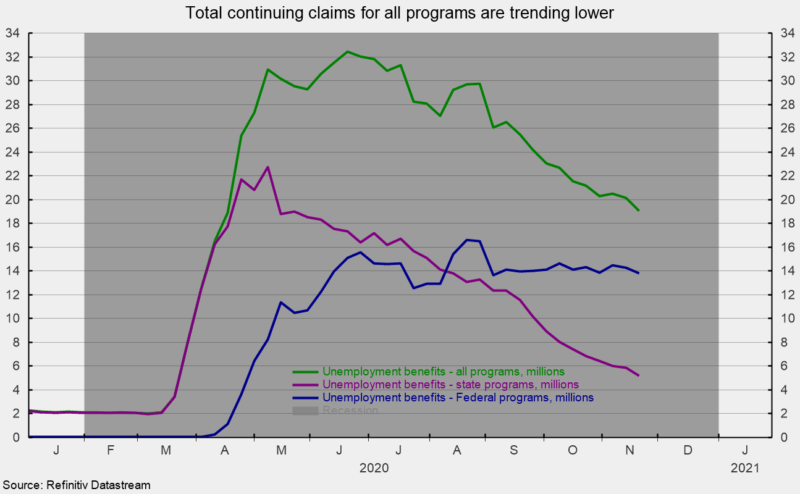Initial claims for regular state unemployment insurance totaled 853,000 for the week ending December 5, up 137,000 from the previous week’s revised tally of 716,000 (see first chart). Claims are now at an eleven-week high, the highest level since September 19. The four-week average was 766,000, up 35,500 from the prior average and the highest since October 31. The latest week is the 38th week of historically massive claims. Prior to the lockdowns, initial claims averaged 212,000 over the first 10 weeks of 2020. It is possible that the weekly data are distorted by the Thanksgiving holiday as weekly seasonal adjustment is extremely difficult. Nevertheless, persistent initial claims at such a historically high level remain a troubling sign for the labor market recovery and the economy. (see first chart).
The number of ongoing claims for state unemployment programs totaled 5.214 million for the week ending November 21, down 676,508 from the prior week (see second chart). For the same week in 2019, ongoing claims were 1.506 million. Continuing claims from state programs have trended lower since the peak in early March. Over the same period, continuing claims in all federal programs have trended higher through late August but have since leveled off and are trending roughly flat, coming in at 13.830 million for the week ending November 21, down 443,000. Since the beginning of September, claims in all Federal programs have averaged 14.116 million (see second chart).
The total number of people claiming benefits in all unemployment programs including all emergency programs was 19.043 million for the week ended November 21, down 1.120 million from the prior week. While there has been improvement from the catastrophic results in March and April, the current level of weekly initial claims is still very high and continuing claims are still massive (see second chart).
Government-imposed restrictions intended to slow the spread of Covid-19 continue to wreak havoc on the economy and the labor market. The longer consumers remain restricted and businesses remain closed or limited, the more uncertain a labor market recovery becomes and the higher the probability of a slow and drawn-out economic recovery.
* This article was originally published here
HELP STOP THE SPREAD OF FAKE NEWS!
SHARE our articles and like our Facebook page and follow us on Twitter!





0 Comments